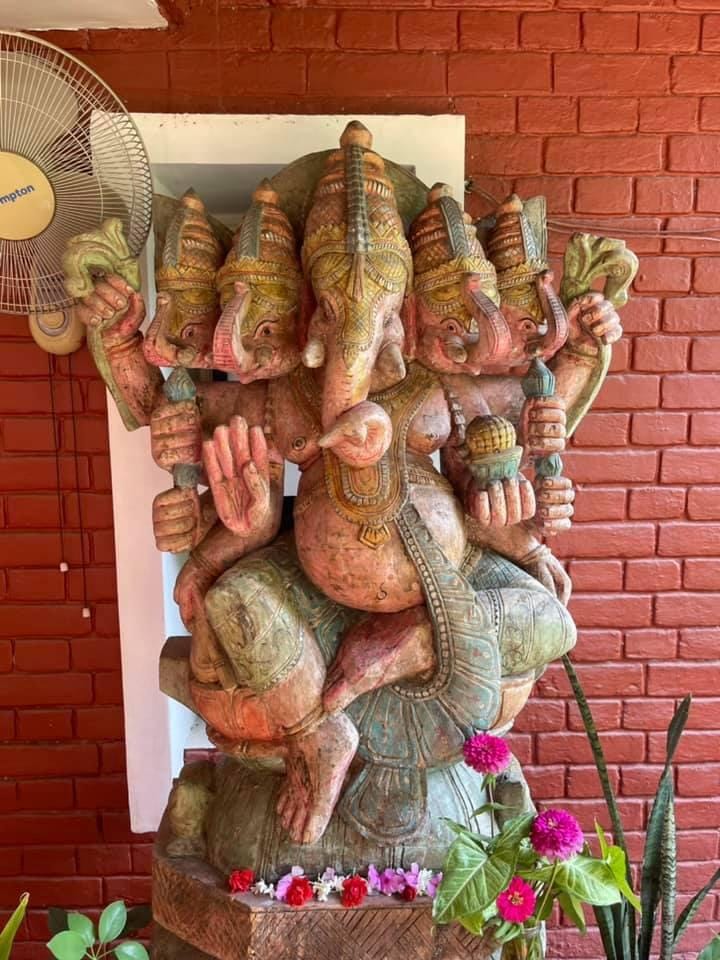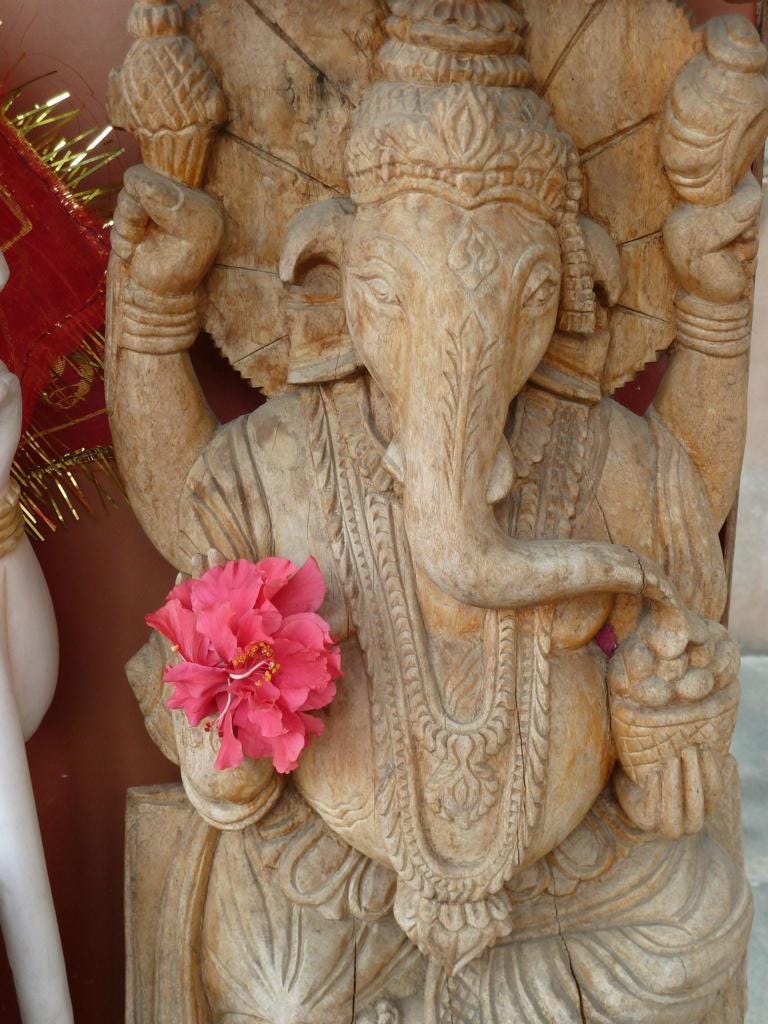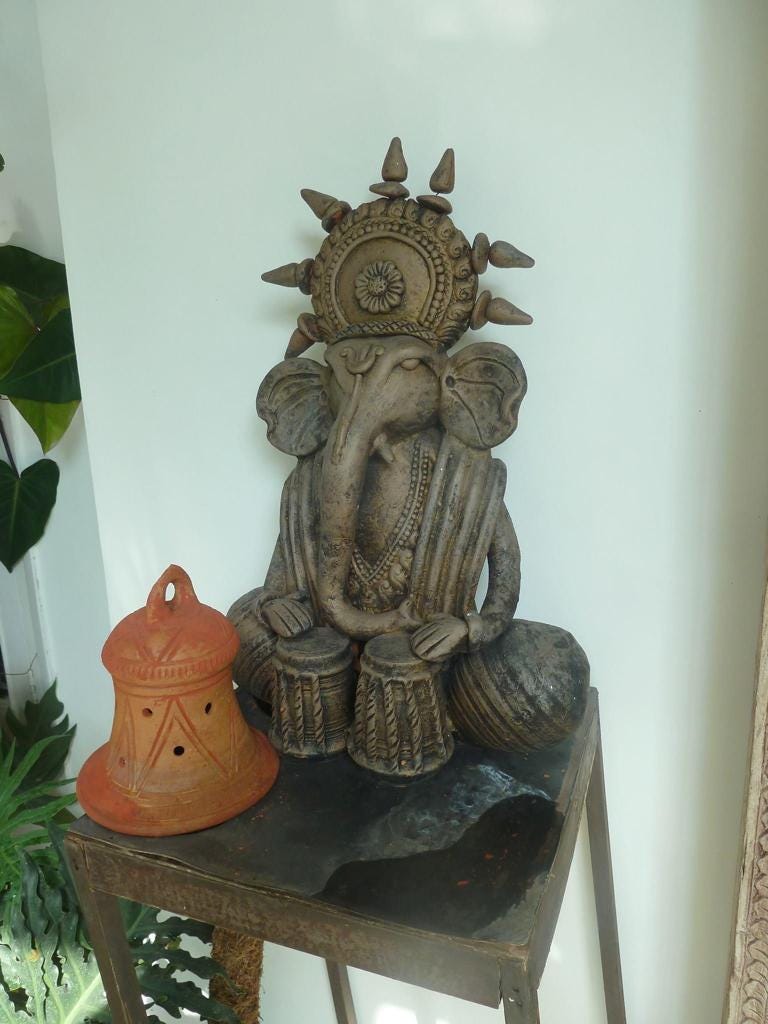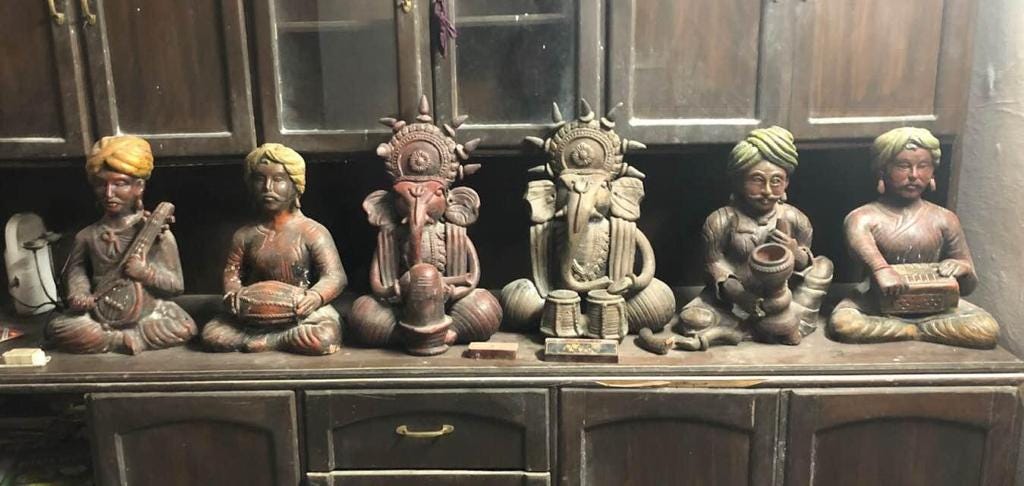Ganesh Chaturthi— गणपति बाप्पा मोरया!
Heartiest felicitations on the occasion of Ganesh Chaturthi, also known as Vinayak Chaturthi.
Ganesh Chaturthi 1990— my first intro
In September 1990, as a young IAS officer with just six years under my belt, I found myself deputed for a fortnight's training at the Institute of Developmental Administration in Pune, Maharashtra. When I perused the training calendar, the absence of a holiday for Janmashtami piqued my curiosity. Celebrated with great zeal in Northern India, Janmashtami seemed conspicuously underplayed here, to the point that it wasn't even designated as a gazetted holiday. However, I was soon told that the real festivities were lying in wait: Ganesh Chaturthi would commence the following week with great fervour.
Hailing predominantly from Punjab, this revelation astounded me twofold. Firstly, it surprised me to see the comparatively low-key observance of a revered deity like Lord Krishna in Maharashtra. Secondly, the intense and vibrant celebrations of Ganesh Chaturthi were quite the contrast, largely unfamiliar to those of us from the north. It was then, over three decades ago, that I became acutely aware of India's intricate tapestry of multiculturalism, even within the expansive umbrella of Hinduism. Now, 33 years on, as the eve of Ganesh Chaturthi, that indelible memory compels me to reflect and write about this unique and widespread festival.
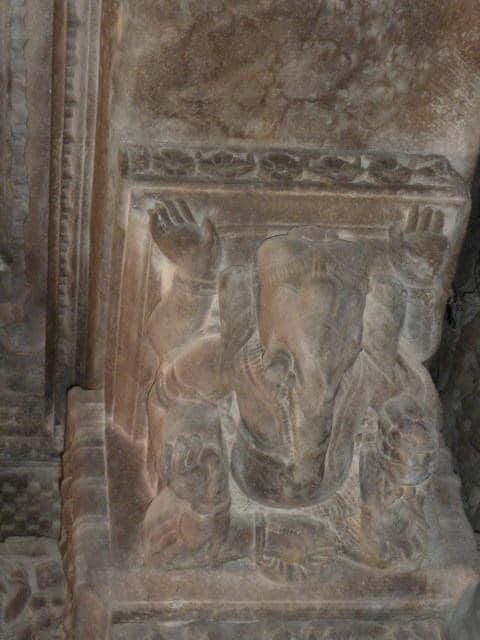
Birthday of Lord Ganesha
Ganesh Chaturthi, also known as Vinayak Chaturthi, is a revered Hindu festival celebrating the birth of Lord Ganesha, the deity symbolising new beginnings and the removal of obstacles. The festival is observed across India, particularly in states like Maharashtra and Karnataka, as well as globally. Marked by the installation of Ganesha idols in homes and public spaces, the festivities include hymn chanting, prayers, and fasting. Offerings such as 'modak,' believed to be Ganesha's favourite sweet, are distributed. The festival culminates on the tenth day, Ananta Chaturdashi, with the immersion of the idols in a body of water.
Tilak Intertwined it with Freedom Struggle
The public celebration of Ganesh Chaturthi gained considerable prominence in 1893, thanks to the efforts of freedom fighter Bal Gangadhar Tilak. Tilak saw the festival as more than a religious observance; he envisioned it as a potent catalyst for India's freedom struggle. Ingeniously bypassing British laws against large public gatherings aimed at stifling anti-colonial activities, he transformed the once private, household-centric festival into a grand public spectacle. This move not only served to unite people across caste and class lines but also gave them a platform for political discourse against British rule. Through speeches, songs, and the dissemination of printed material, Tilak was instrumental in galvanising the people of Maharashtra, and by extension India, instilling in them a fervent sense of nationalism and collective identity. Thus, the festival of Ganesh Chaturthi metamorphosed into a significant vehicle for social and political unity during the British era
Ganesh Chaturthi this Year
In Goa, despite historical prohibitions imposed by the Jesuits during the Inquisition, devout followers found ingenious ways to celebrate Ganesh Chaturthi—utilising handmade idols or intricately designed paper images to discreetly honour Lord Ganesha. As we find ourselves on the cusp of this significant occasion, falling on today and tomorrow, the 6th and 7th of September, Ganesh Chaturthi serves as a unifying tapestry of devotion and festivity. On this auspicious occasion, we extend our warmest felicitations and greetings to everyone. It also presents us with a timely opportunity to delve into the rich tapestry of symbolism, history, and lore surrounding this universally revered deity. Allow me to elaborate further

Lord Ganesha’s Family
Lord Ganesha, is the son of Lord Shiva and Goddess Parvati and has a younger brother named Kartikeya, also known as Murugan or Skanda, the god of war. Lord Ganesha himself is widely revered as the deity of wisdom, new beginnings, and the remover of obstacles. In terms of his family life, he is said to be married to two goddesses: Riddhi, symbolising prosperity, and Siddhi, representing spiritual power. This divine family setup offers a complete picture of the various aspects of life—destruction (Shiva), motherly love (Parvati), warfare and bravery (Kartikeya), wisdom and beginnings (Ganesha), prosperity (Riddhi), and spiritual enlightenment (Siddhi). Together, they encapsulate the full spectrum of cosmic functions and human aspirations.
The Elephant Head
The story of how Ganesha got his elephant head varies slightly depending on the text, but one popular narrative comes from the Shiva Purana. According to this tale, Goddess Parvati created Ganesha out of clay to guard the entrance while she was bathing. When Lord Shiva returned and was denied entry by Ganesha, a fight ensued, and Shiva severed Ganesha's head. Seeing this, Parvati was filled with sorrow. To placate her, Lord Shiva ordered his followers to bring the head of the first animal they could find, which happened to be an elephant. Ganesha's original head was replaced with that of the elephant, and he was brought back to life. This act bestowed upon Ganesha his distinctive appearance and also symbolic wisdom, as the elephant is considered one of the wisest animals
An auspicious god
Lord Ganesha is often referred to as 'Vighnaharta' (the Remover of Obstacles) and is invoked at the beginning of any new venture, be it spiritual or temporal. His role as a 'mangal moorti' (auspicious form) and 'sukh karta' (creator of happiness) makes him one of the most widely worshipped deities in Hinduism. In addition to being the god of beginnings, he is also the deity of wisdom, intelligence, and learning. As the god of New Beginnings, any ritual, ceremony or new venture customarily starts by invoking his blessings. His presence is considered as a protective and purifying influence that clears obstacles, both spiritual and material.
The story and symbolism of Lord Ganesha convey timeless lessons of devotion, wisdom, and the power to overcome challenges, making him not just a revered figure but also a teacher and guide in the Hindu tradition.
The immersion of Ganesha idols, also known as "Ganesh Visarjan," is an integral part of the Ganesh Chaturthi festival, which is widely celebrated in India, particularly in the state of Maharashtra. The festival usually spans a period ranging from one and a half days to up to 11 days, culminating in the immersion of the idol in a water body like a river, sea, or even a purpose-built temporary pond.
Symbolism and Significance
Cycle of Creation and Dissolution: The act of immersion symbolises the cycle of creation and dissolution in nature, a core concept in Hindu philosophy. Just as Ganesha is created (usually from natural materials like clay), he also returns to the Earth, signifying the impermanent nature of life.
Removal of Sins and Obstacles: It is believed that when the idol is immersed, Lord Ganesha takes away the various obstacles and problems of devotees with him, purifying their lives.
Environmental Respect: Traditionally, the idols were made of biodegradable materials, emphasising the harmonious coexistence of man and nature. Unfortunately, with the advent of plaster of Paris idols, this aspect has been somewhat compromised, but there is a growing awareness and return to more eco-friendly options.
Community and Unity: The act of immersion is often a grand communal event, symbolising unity and collective spirituality, bringing together people from different walks of life.
Spiritual Renewal: The annual festival and subsequent immersion are also a reminder to the devotees that God resides not just in the idol but in everyone and everything. The immersion is seen as a kind of spiritual renewal, a reminder to look inward and see the divine in the heart and in the everyday world.
Detachment: The ritual also teaches the value of detachment, signifying that just like the idol, all material things in life are temporary and should not be the focus of undue attachment.
Journey of the Soul: On a deeper, spiritual level, the immersion is symbolic of the human soul's journey through the cycle of birth and rebirth, ultimately merging with the divine.
In summary, Ganesh Visarjan is a deeply symbolic and spiritually charged ritual that encapsulates several aspects of life, philosophy, and spirituality in Hinduism.
Summing up and Immersing Ourselves in the Fervour of this Festival
Reflecting on my own experience in 1990 as a young IAS officer, the dynamism of Ganesh Chaturthi opened my eyes to India's extraordinary tapestry of religious and cultural diversity. The festival, centred on a Hindu deity, serves as a magnificent exemplar of how faith can transcend the limitations of geography, caste, and even religion itself. In many parts of India, people from different faiths come together to participate in the festivities, underscoring the universal themes of unity, new beginnings, and the removal of obstacles that Lord Ganesha represents. This speaks to a broader truth about India—a nation where multifaceted identities coalesce, yet retain their unique cultural heritage.
Personal Reflections
As I absorbed the variances between the observance of Janmashtami in the North and Ganesh Chaturthi in Maharashtra, it felt akin to attending an impromptu but enriching masterclass on India’s inherent pluralism. As the drums roll and the chants fill the air this year, may Lord Ganesha bestow upon us the wisdom to appreciate our differences and the vision to see the unity that makes us fundamentally Indian. We extend our warmest wishes to everyone on this auspicious occasion. May Lord Ganesha remove all obstacles in your path and bless you with prosperity, wisdom, and happiness.

The Spiritual Significance of Ganesh Visarjan
As the joyous festivities of Ganesh Chaturthi come to a close, the ritual of Ganesh Visarjan marks the festival's culmination. In 2024, the Visarjan occurs on Anant Chaturdasi, falling on Tuesday, 17th September. The auspicious timings for Visarjan on this day are as follows: Morning Muhurat (Labha) from 6:33 AM to 8:00 AM, Afternoon Muhurat (Amrita) from 12:21 PM to 1:48 PM, Evening Muhurat (Shubha) from 4:42 PM to 6:09 PM, and Night Muhurat (Labha) from 11:36 PM to 1:03 AM on September 17th and 18th. While these are considered the most favourable times, Visarjan processions and immersions often continue throughout the day and night, particularly in areas with large-scale celebrations. Devotees are encouraged to perform the Visarjan ritual at a convenient time within these auspicious periods.
The act of Visarjan, or immersion, is deeply symbolic. The clay idol of Lord Ganesha, which was invited into homes and public spaces with much pomp and splendour, is returned to water. This ritual represents the natural cycle of creation and dissolution, mirroring the transitory nature of life itself.
In Hindu philosophy, the physical form is seen as merely temporary, and the Visarjan serves as a poignant reminder of this belief. The immersion signifies the departure of Lord Ganesha to his heavenly abode, taking along with him the prayers of his devotees and leaving behind his blessings. The act is often accompanied by the chant "Ganapati Bappa Morya, Pudchya Varshi Laukariya" which translates to "O Lord Ganesha, come back early next year," signifying the people's anticipation and warm welcome for the deity in the year to come.
The event is not just a religious ceremony but also a communal celebration that unifies people across various strata of society. Communities come together to participate in the processions leading to the water bodies for the Visarjan, making it a grand spectacle imbued with devotion, music, and dance.
Though the idol may dissolve, the essence of Ganesha—embodying wisdom, prosperity, and good fortune—remains in the hearts and homes of the devotees, eagerly awaiting his return the following year.




